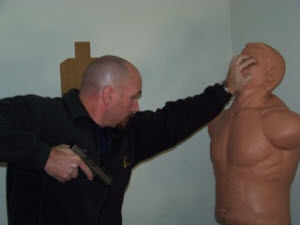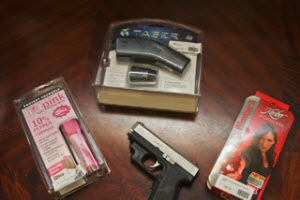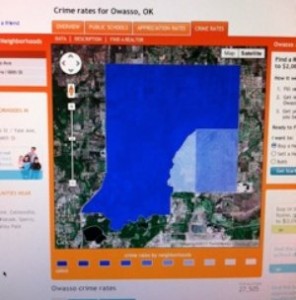
For those of us who really like to shoot, going to the range and training is easy and fun … but there are several other things you should address to complete your self-defense plan.
I recently took a step back and asked myself in what areas my self-defense plan was lacking. What could I do to improve my overall ability to defend myself and my family? After giving it some thought, I created a self-defense to-do list that might surprise you. If you’ve read my articles here on PDN, you know that I love to shoot, teach shooting, and write about performance-related subjects that will improve your ability to run a gun in any situation. But my goal in this article is to present a prioritized checklist of items that I hope will make you think about your self-defense from a different angle.
1. Find a qualified first-aid course and take it. Work your way up to advanced emergency lifesaving techniques.
2. Take a serious look at your physical fitness level. Embrace a lifestyle of fitness and healthy eating.
3. Tell your self-defense plans to your family. Ensure each member has an “if-then” plan.
4. Address the weaknesses of your residence. This includes everything from basic concepts like getting the kids to lock the doors up to higher-level security concerns.
5. Find a qualified instructor who teaches quality empty-hand combatives and train to a high level of skill with these techniques.
6. Research and employ intermediate levels of force options. These might include chemical sprays, electric stun tools, and other items that would be used instead of lethal force.
7. Research crime trends in areas you frequent, and practice avoidance of those areas or awareness while in them. Educate your family members.
8. Continue your education and training with your primary weapon system (in this case, handgun), and get additional training with any other weapons you might use for self-defense (such as a home defense rifle).
For those of us who really like to shoot, going to the range and training is easy and fun … but there are several other things you should address to complete your self-defense plan. Are you shocked to find firearms-related training last on the list? How can this be, coming from Mike Seeklander, the guy who promotes, teaches, and constantly tells you to train harder on the range? The simple answer is that there is much more to self-defense than just training to use a firearm. While that aspect is critically important, consider the likelihood of having to use your handgun to defend yourself versus the chance that you might have to perform a lifesaving first-aid technique such as CPR or the Heimlich (choking victim) Maneuver on a loved one. Imagine being well trained with your carry gun and having the ability to fend off any attacker only to have your child die because you did not have the first-aid skills to save them! The second item on the list is fitness. Why? Simply because being physically fit will aid you in a fight … and even more importantly, heart disease is one of the number one killers in the U.S. Open your mind and consider that defending yourself means more than just getting a carry permit and going armed.
Let me break each area down in more detail. This will allow you to think about each concept, assess your plan, and do what is necessary to address your individual weaknesses. Some items on the list may not apply to you (or me), so pay particular attention to addressing your weak areas.

Having the knowledge to save yourself or a loved one may not involve fighting your way out of a bad situation. Working knowledge of first aid and emergency care might make the difference between life and death.
First Aid
Find a qualified first-aid course and take it. Work your way up to advanced emergency lifesaving techniques.
I have always worried that something would happen to a family member and I would not be able to help them. I got really serious about this when my son was an infant, knowing how fragile the little guy was and how different first aid was with someone that age. I recommend starting with the basics and taking a first-aid course such as the ones that can often be found through the Red Cross. These courses will be taught in the community or at a local college. Sometimes they are free, but usually they have a nominal fee and are well worth the investment. Once you know simple first-aid techniques, consider taking some advanced courses that might be more applicable to a situation where you are involved in a high-stress encounter and someone gets severely injured. You never know — you might end up treating yourself.

Fitness is important for overall health, and you are much more likely to face a health issue than an armed attacker. But if you are involved in a fight for your life, such as this case with multiple attackers, your fitness level will make the difference between success and failure.
Physical Fitness
Take a serious look at your physical fitness level. Embrace a lifestyle of fitness and healthy eating.
As stated above, heart disease is one of the leading causes of death in the U.S. Imagine that! You are statistically much more likely to be affected by the choices you make regarding diet and exercise than you are to be attacked and killed by an armed intruder. I often run into “gun guys” who excuse their poor physical condition by telling me that is why they carry a gun … because they are just going to shoot someone rather than fight them. First of all, it is not always that simple, and second, those guys are often the ones who die at a much younger age due to complications caused by an unfit lifestyle. There is so much information out there about getting fit (at any age) and eating healthy it’s almost confusing. My recommendation is to follow the advice of a good trainer who understands your goals and is not just focused on bodybuilding. I spend the majority of my fitness time doing functional moves that directly complement my combatives skill.
Family Communication
Tell your self-defense plans to your family. Ensure each member has an “if-then” plan.
This is an absolute must, yet I have found it is often ignored by people who carry a gun. Not communicating to your family what you plan to do and what you want them to do can have life-threatening consequences. Imagine your child running into the line of fire and getting struck by you or the attacker if they did not know what to do in a high-stress situation like an active shooter. The only way you can possibly expect your family to act under this level of stress is to develop a plan and practice it. I recommend that you develop some simple communication phrases that will cause an immediate response from your spouse and/or children. It’s also important that you and they understand key tactical concepts such as the line of attack and simple ballistics, so that your family knows where they should not be during a shooting situation. Once you have your plan discussed, practice it in a controlled setting. Make sure you communicate to your family that you will never “cry wolf” and practice your plan in public, and that if you ever use your key phrase when you’re out and about, it will be for real.

This suction cup can be purchased for less than $20 and is a key tool criminals use to pull sliding glass doors off their track and defeat the locking mechanisms. Addressing the weak areas of the home is an often overlooked aspect of real self-defense. Make sure you don’t overlook this!
Home Security
Address the weaknesses of your residence. This includes everything from basic concepts like getting the kids to lock the doors up to higher-level security concerns.
I’m amazed at how often I have to remind my own family members to lock the front or rear doors when they enter the house. I think that we often fall into the “I live in a safe neighborhood” mindset trap and forget that predators prey on victims who are the most unprepared. If you visit the roughest parts of town, you find street-smart families and people who have learned not to be victims. In areas like the one I live in, you find unaware residents who think the location of their home keeps them safe. This method of thinking often leads to the “it can’t happen to me” mentality, which leaves you (and your home) wide open to criminals. Address the weaknesses of your residence. This might include unlocked doors and windows, garage doors that can be opened without a code or lock, sliding glass doors that are not locked properly, and poorly lit areas where an intruder can hide. Violent home invasions are not uncommon, and they happen in good neighborhoods. Learn the trends and discuss how these predators prey on their victims, and the security measures you need to take with your family.

Integrating empty-hand and firearm skills is a complex process that relies on having a solid foundation of striking and grappling techniques. I am working on striking and shooting at the same time, an advanced skill that allows me to defend my handgun from a grab yet still utilize it if lethal force is warranted.
Empty-Hand Combatives
Find a qualified instructor who teaches quality empty-hand combatives, and train to a high level of skill with these techniques.
Time and time again, I have come to the conclusion that having empty-hand skills is vital in relation to real self-defense. The majority of attacks occur at close range, and having the ability to defend oneself against a physical attack is a huge part of the equation. Getting the gun into the fight where there is justification also requires empty-hand skills at close range. Another important reason to have solid empty-hand skills is the ability to have a tool other than lethal force for certain situations. If I can deflect an attack utilizing unarmed skills and diffuse the situation rather than resorting to a weapon, that is going to be a win-win in any case. Another side benefit is the confidence I will possess by having solid unarmed skills that allow me the option of making choices other than lethal force, if they exist. If possible, not using lethal force is always going to be the best choice.

Anyone serious about self-defense, and especially those who are less skilled with empty-hand combatives, should consider other force options like chemical sprays and electronic stun tools. While lethal force may still be necessary, being able to resort to something less deadly is preferable.
Intermediate Levels of Force
Research and employ intermediate levels of force options. These might include chemical sprays, electric stun tools, and other items that would be used instead of lethal force.
This is an area where I myself have fallen short. I always arm my spouse with some sort of chemical spray, but may not have something myself, because I’m always armed. The problem is that if all you have is a hammer, everything looks like a nail. While I am confident of my empty-hand skills, using them means I have to get very close to someone, close enough that they might realize I’m armed. Chemical spray is a great intermediate solution to an aggressive assault that might not warrant deadly force at that moment. Not having it limits your options and forces you to close with and use empty-hand skills, move away and create distance (not always easy with small children), or resort to a firearm. Once again, having other options is my choice and if possible, I recommend utilizing something that allows me to defend myself without using lethal force. Electronic stun devices are great tools for this, but my last choice since they often require very close proximity to use. I prefer an option that allows me to maintain more distance yet is still effective.

With several simple mouse clicks, I had a color-coded map of my area, even color-coded with higher crime rates. Information such as this is readily available. Knowledge is safety!
Crime Trends
Research crime trends in areas you frequent, and practice avoidance of those areas or awareness while in them. Educate your family members.
It seems that the only source of information we count on these days for pertinent facts is our local major media outlets. You will be way ahead if you keep a keen eye on the crime trends in your area. A neighborhood or district that has a high number of violent assaults over a given period of time is one to be avoided, yet often the news media will not tie those trends together well. I recommend contacting your local police agency to see if they track crime statistics (I can almost guarantee they do), and find out what data they can provide. Avoidance and awareness are terms we preach in training classes, but avoidance is the first step in the process, and to avoid anything you must first be aware of it. Remember that criminals are creatures of habit, and if they are having success preying on innocent victims in one area, they will likely continue to be active there. If you know where those places are, you can simply avoid them; or if you are forced to go there, you’ll know to practice increased awareness.

Range training is very important, but work on skills that fit the context of the situation you might be faced with. I am working on shooting around a low piece of cover – think of a desk providing cover from an armed intruder. If you can’t practice techniques like this on your range, do it with an airsoft gun.
Weapons Training
Continue your education and training with your primary weapon system (handgun in this case), and get additional training with any other weapons you might use for self-defense, such as a home defense rifle.
Just because this is last on the list doesn’t mean it’s the least important! I strongly believe in training regularly. This means committing to a range visit weekly, or at least utilizing dry fire or alternate methods of training such as an airsoft gun to hone or maintain your skills. Years ago, I used to tell the graduating students in Federal Air Marshal classes to “take responsibility for your own survival.” I knew that they would have obstacles to overcome when they reached their field offices, and training often takes a back seat to the mission. In your case, it’s easy to find excuses for your failure to train with your firearm(s), but in the end you will have to deal with the consequences.
In closing, I hope you take these self-defense suggestions and act on them, as action is always stronger than intent. Most importantly, address your own self-defense strengths and weaknesses and objectively look at areas you might have previously neglected.
Mike S. I teach all over the U.S., and if you would like more information please email me or visit my website (www.shooting-performance.com) I would love to train with you! @ Alfred, thanks for the comments as well as sharing my checklist!!
Always good stuff from Seeklander. I especially appreciate the emphasis on first-aid and emergency medical training. ~~ ZT
Hey Mike, Thank you for this thought provoking Self-Defense Checklist! As a veteran police officer, high level dignitary protection agent and radio talk show host, I am often asked about what are some of the top strategies to increasing personal security, safety and emergency preparedness for individuals and loved ones. Your checklist highlights some extremely important ideas and concepts that many people may not even think about when it comes to real personal security and quality safety measures that ultimately center on having a solid and practiced plan to take personal responsibility for your OWN survival in any situation. I am definitely going to share this checklist with my family, friends, colleagues and listening audience. And by the way, I was going to "Blow Off" going to the gym today for another work-out session but, after reading your checklist and the importance of physical fitness, it's off to the gym I go. Be Vigilant, Be Prepared, Be Safe! Alfred McComber, Host Code Red! Radio Show www.CodeRedRadioShow.com
Anyone who carries a gun should carry pepper spray. Failure to do so implies that all they are willing to do to protect themselves is use deadly force. That's not a statement most people are willing to make when they think about it a bit.
thnx Mike for support and help :)
you have any local training???iive heard comments abuut a course given to an outfit in navada.